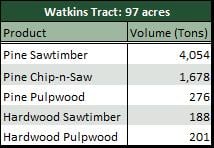2 min read
Timber Inventory Basics: The First Step in a Timber Harvest
 Joe Clark
:
November 11, 2014
Joe Clark
:
November 11, 2014

Prior to a timber harvest, timberland owners determine both whether timber is ready for harvest and how much of that timber is merchantable by conducting or hiring someone to conduct a timber inventory or “cruise.”
Conducting an accurate timber inventory is key to getting maximum value from a timber sale. Because it requires specialized knowledge and equipment, most timberland owners hire a certified consulting forester to conduct the inventory.
Since it is usually not economically feasible to count and measure all trees, a consulting forester samples the property to estimate the volume of wood products on the entire tract. Sampling methods involve traversing the property in a systematic grid-like pattern and counting and measuring trees in plots or strips at predetermined intervals along the grid lines.
In plot cruising, plot lines are laid out across the tract and individual circular plots are laid out at predetermined areas. Spacing is dependent on the variability of the timber and the sampling intensity that is desired. Then, the DBH and height of all individual trees that lie within plots are tallied. Commonly, 10-20% of the timber is sampled employing 1/10th acre plots.
A related method used is the point method, which involves using a wedge prism to determine which trees to tally at systematic points along the grid lines. Again, 10-20% of the timber should be sampled.
Strip cruising typically involves measuring all trees within various product classes (pulpwood, sawtimber, chip-n-saw, etc.) that lie within 33 feet (1/2 chain) of either or both sides of the traverse line. If 1 chain sample strips are placed 5 chains apart, then the sample size will be 1/5 or 20% of the entire tract. Strip cruises are less accurate (more prone to under or over estimate the amount of volume on a tract) when compared to the plot and point method cruises.
In all of these methods, the DBH (diameter at breast height) and the height of all individual trees that lie within the strip or plot are measured. Volume tables are then used to measure each tree’s volume and the strip’s or plot’s total volume is calculated by adding the volume of each individual tree. To compute the volume estimate for the total tract, the accumulated sample volume is multiplied by 5 if 20% was sampled and 10 if 10% was sampled.
 The volume estimate is central to estimates of the value of the timber and serves as an important data point when making many of the other decisions that are required once you decide to sell your timber. The volume estimate for the 97-acre Watkins tract might look like the table to the right.
The volume estimate is central to estimates of the value of the timber and serves as an important data point when making many of the other decisions that are required once you decide to sell your timber. The volume estimate for the 97-acre Watkins tract might look like the table to the right.
To ensure greater accuracy of the volume estimate you receive, be sure to request the cruise statistics from your forester. Cruise statistics give you an indication of how reliable/accurate the cruise is in producing the average volume that is reported by the consulting forester (as in the Watkins Tract table). The upper and lower limits of the range are based on a confidence interval. I have simplified this example for the purpose of illustration, but if a 90 percent confidence interval showed an 8.3 percent error, the estimate of 100 tons on a stand has a 90 percent chance of falling in the 92-108 ton range once it is weighed at the mill. Knowing these cruise statistics will give you a better indication of the quality and reliability of your timber volume estimate.
Have a timber inventory? Read our tips for hiring a logger.
Has hiring a consulting forester to conduct a timber inventory benefited you? Share your story here.





